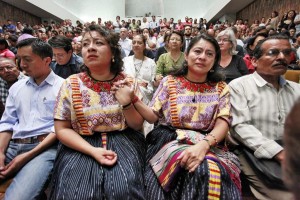
Two indigenous women sit at the trial of Efraín Ríos Montt shown in 500 Years, Yates third film; photo credits: Daniel Hernández-Salazar
This documentary is the second in an assumed trilogy by Pamela Yates that centers on the indictment of General Efraín Ríos Montt for his perpetuation of the Mayan genocide during the 80’s-armed conflict. Yates’ previous film, When the Mountains Tremble, released in 1983, centered on the Guatemalan armed conflict between the Guatemalan national army and the guerrilla, rebel forces. Many of those affected by the conflicted were the countless Mayan indigenous people and ladino peasants (non-indigenous, mestizos who were poor). This was very astounding given that 40% of Guatemala’s population consists of indigenous Mayan people. In the aftermath of this violence, there were brutal murders of nearly 200,000 Mayan people and many more disappeared.
This film in particular flashes back to her previous film, which she filmed at the center of the armed conflict in Guatemala because there was a lot of first-hand witnessing of the Guatemalan soldiers in action and interviews with many of them. Granito serves as a reflection on capturing the Mayan genocide that was taking place during the time of filming the initial film. As seen in the film, Yates’ original film seemed to be the only first-hand evidence that human rights lawyers could use to indict General Ríos Montt. The lawyers, specifically in Spain, wanted to indict him of knowing that the Mayan people were being killed in genocide under his rule and power, but they had no other evidence that could prove such claim. Throughout the film, you hear and see from Yates as she reflects on her film from 1983, recounting moments when she interviewed Ríos Montt to her, and other indigenous people, speaking to a judge so that his trial could take place.
This film reflects on the previous film of the armed conflict recounting trauma from the Mayan people and seeking accountability and justice on the part of Ríos Montt for the violence he enacted on indigenous people in Guatemala.
Stoll, David. “Genocide in Guatemala?” Academic Questions, vol. 31, no. 2, 17 Apr. 2018, pp. 219–226., doi:10.1007/s12129-018-9702-8.
(by Andrés Pérez Correa)



